This post will discuss some specific archaeological projects and excavations at VIOE (Flemish Cultural Heritage Institute) include the excavation of the ancient city of Walraversijde and the reconstruction of some old houses, research plan for the "Kogge of Doel," project of the heritage afloat and the "Buiten Ratel Shipwreck." The following three projects were ongoing projects at VIOE during my postgraduate thesis project at Catholic University of Leuven, Belgium, which I have chosen as my research cases.
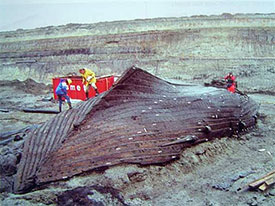
The condition of the Doel cog after excavation (Photo copyright VIOE).
Doel Cogs
Cogs in general were sea-going vessels during the middle ages, which were mostly used in the northern and northwestern areas of Europe.1 The two Doel Cogs of Belgium have been found in upside down position during an excavation for a construction site in August 2000. They were about 4 m under the earth, in the left bank of the river Scheldt, northeast of Antwerp. The larger cog (20m long, is 7 m wide) could be considered as the first complete medieval boat discovered in Flanders since the 19th century.2 In general there is not that much historical information about the Doel Cogs available.
The following technical activities and documentation were done after their recovery by ADW3 and prior to their dismantling:
* Drawings and sketches made during the salvage recovery.
* The three-dimensional model generated from the laser scanned data.
* A rudimentary inventory of sectioned parts and their location.
* Images of the excavation and timber storage condition.
* Interviews with key personnel.
* Planning documents that have been proposed to date.
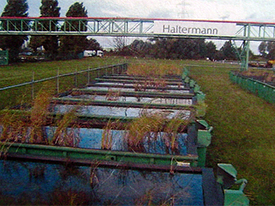
The present condition of the planks and the water tanks where the planks are kept (Photo copyright VIOE).
After having been documented, the cogs were dismantled and the timbers are currently stored in water tanks. The last extensive study which has been done on this relic was done through a joint project between VIOE and A&M- University of Texas by visual observation, analytic sampling and document review. There is damage on the planks consisting of dehydration, acidic condition, bacterial activities and biological growth, largely due to the manner of their storage.4 This research showed the necessity of an urgent conservation plan for these two relics.
Buiten Ratel
Buiten Ratel wreck was a sail shipwreck from the 18th century.5 Its name is taken from the area where the wreck lies in the North Sea, in the Belgium territory water. The site is a flat sand component, in the depth of 10 to 12m.
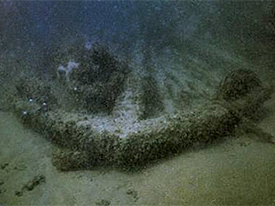
The anchor of Buiten Ratel wreck (Photo copyright VIOE).
This wreck site is one of the MACHU projects.6 The artifacts and objects found from this site are a variety of wooden segments, ceramics, metal objects (nails) textiles, glasses, stone, bone, sulfur, wax and vermillion. Wine and cork are also preserved.7 The objects which have been found within the site mostly have been transferred out of water; some have been examined and studied in the laboratory.8
Some measurements done by side scan sonar and multi-beam are available, from which the orientation, the general view of the site, and its condition are clear. Still a great amount of the site is under the sediment.
Not only the underwater currents cause erosion. The variable condition of the environment in different seasons brings more damage to the site. The growth of a large amount of algae changes the chemical condition of water, and introduces more oxygen into water.9 To conserve this site for the future study, research and presentation, a plan for stabilizing the site or displacing it is recommended.
World War Shipwreck- Bourrasque
The importance of the World War shipwrecks becomes clear when we notice the importance of the on-land World War heritage; the bunkers along the North Sea- so called Atlantic Wall- which attract so many visitors; the intangible values of the war's cemeteries, as well as technical and naval aspects shows the values of this cultural heritage. Some shipwreck sites from the WWs are considered as graveyards as well.
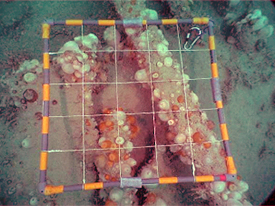
There is no large structure emerging from the sand. Some parts of the structure are visible, although they have been covered with biofouling and plants (Photo copyright VIOE).
As the first and the most studied shipwreck in Belgium , we can mention the Bourrasque, identified in 1984.10 It was a French military vessel 105.77m long, 9.64m wide and 4.30m high (1925).11 On May 30th, Bourrasque was on its way with 600 French soldiers on board when it was hit by a coastal gun. This site has been considered as a war-grave as well , located off the Belgium coast.12 The wreck is broken in two halves.13
This wreck has also been chosen to be studied by VLIZ- for biological studies- due to its length, good state, position and the date of sinking which is more than 10 years ago, so the colonization by animals already took place. The variety of underwater flora and fauna has given the site aesthetic value, as well as high value for biological research.14
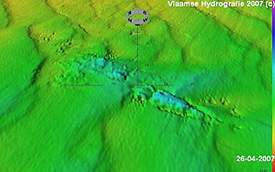
Outcomes of the survey done by multi-beam and side-scan sonar (Photo copyright VIOE).
More data has been generated by applying new techniques; multi-beam and side-scan sonar, which can show the amount of the site above the seabed.15 There are also some virtual 3D models of the battleship produced, which could be helpful to have a virtual presentation.16
This shipwreck is of natural and historical importance, but in general the remains of the Bourrasque wreck are in bad condition and it is impossible to say how the condition of the buried part is.17
In Belgium a preliminary step has been taken towards a general understanding of what is going on; still a series of guidelines to homogenize the whole project is missing. Following a guideline we could decide exactly what to do with different categories of underwater cultural heritage in Belgium, and furthermore, there would be the possibility to integrate whole projects which have something in common on land and underwater.
As a part of my research I provided a series of recommendations in the form of short term, middle term and long term plans for the future of these cases. In brief, the short-term and mid-term programs could be defined by each individual project, but still a vaster view towards the future is needed. The short term decision could be made according to the urgency of the relic's condition, with some preliminary study. And the mid-term ones could be considered as a transit between the short-term and long-term. The stage of mid-term is very crucial; at this stage we need a series of guidelines in order to build up the future master plans. In order not to miss any important aspects in safeguarding the tangible and intangible values of underwater cultural heritage, a multidisciplinary research and approach is necessary.
Return to In The Field home page.
Footnotes:
1 http://en.wikipedia.org/wiki/Cog_%28ship%29
2 According to VIOE and ADW (Archeologische Dienst
Waasland) scientists.
3 Berichten van de Archeologische dienst Waasland, Overdruk uit annalen van de koninklijke oudheidkundige kring van het land waas 104 (2001), p. 437-484.
4 The border of the tank farm is a chain-link fence about 1.75 m high with an additional three strands of barbed wire approximately 0.5 m high encircling the top. The tanks sit in rows directly on the grass, but the ground undulates under the four corners of the tanks and supporting soil is not always firm enough to prevent the heavy corners from sinking below grade.
5 http://www.maritieme-archeologie.be/
6 http://www.machuproject.eu/wrecks/be/buitenratel01.htm
7 Report from the excavations and studies done by VIOE.
8 From author visit to the laboratory in Zelik where the objects are stored and tested.
9Interview with Dr. Marnix Pieters, the head of Underwater Archaeology Department of VIOE at the time of this research.
10 In consultation with Pieter Marnix, Head of Deapartment of Underwater Archaeology, VIOE.
11 1.458 tons; 347x33x13.7; 33.000 ihp; 33 knots; turbine engines; four 5 in guns, two 37mm; 6 T.T.
12 http://www.wrecksite.eu/wreck.aspx?6
13 http://www.maritieme-archeologie.be
14 http://www.mumm.ac.be/EN/News/item.php?ID=18
15 http://www.vlaamsehydrografie.be/wrakken/detail.aspx?id=45
16 http://www.mumm.ac.be/EN/News/item.php?ID=18
17 According to the interview done with a scientist from VLIZ, Dr. Vincent Zintzen.
Comments, suggestions, or questions can be directed to research@themua.org




